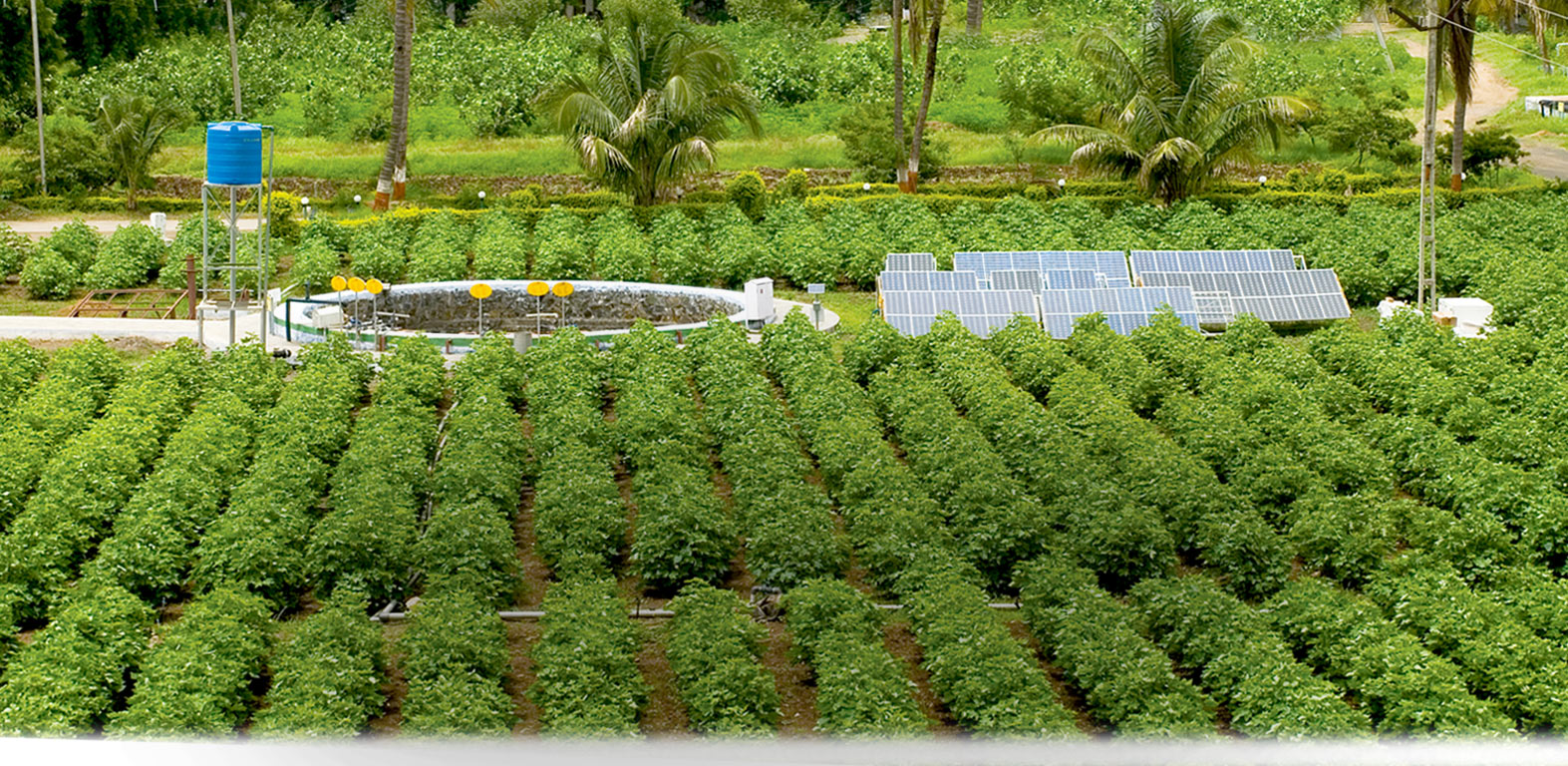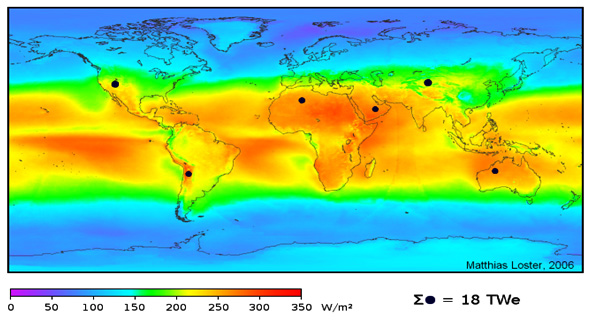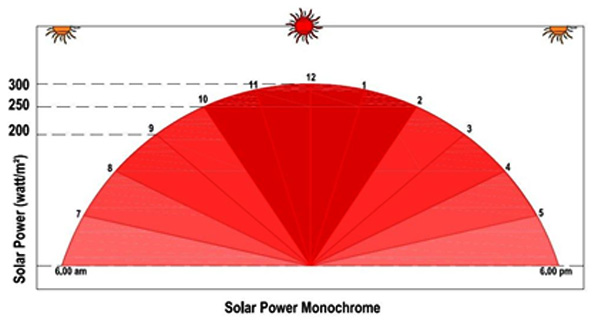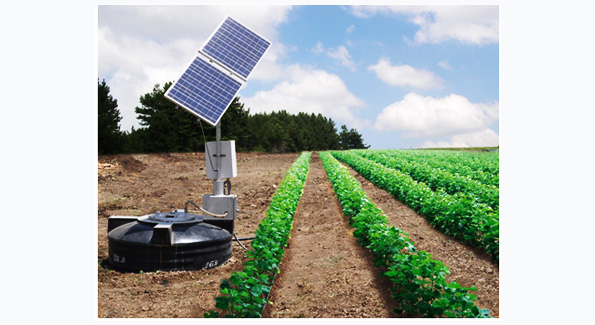Welcome to Jain Irrigation Systems Ltd.

Blog at Jains - Jain’s Solar Powered Micro Irrigation System, Promising Option for Agrarians
Solar power is very curious subject flaming all over world in all sectors from space station to agro-irrigation because of unlimited availability of free solar radiation without proprietorships and non-judicial! Concerning to use of solar power in micro irrigation sector is in primeval stage because of lack of unawareness on design aspects and exceptional types of electro-mechanical machines to pressurized micro irrigation system. The concern article throws light on fundamentals of solar energy and allied critical aspects in solar powered micro irrigation system.
In broad-spectrum micro irrigation is a pressurized irrigation system requires electrical/gasoline powered centrifugal pump-set to generate unswervingly pressure for irrigation of crops mainly for 16-20 hours to meet the crop demand on daily basis. Means, while irrigating the crops for 16-20 hours on daily basis, recurring cost of electricity or fuel becomes enormous resulting in non-sustainability and viability of agri-irrigation projects. That’s the reason in many parts in the world agriculture is diminishing and agriculture land is turning to desertification. Second hot issue is shortage of power! Demand vs supply ratio of power is so truncated every year, that none of the Government is enduring to overcome this ratio in future in spite of allocation of huge funds. UN report says that there is a deficit of 21-85% electricity in many countries and increasing @ 7-15 % every year. Hence, more thrust is given to alternative renewable and sustainable source of energy i.e. Solar Power! Although, solar radiation is freely available, it has limitation and is not so cost effective to afford & reliable to everyone.
Solar Photovoltaic (PV)
The photovoltaic effect refers to photons of light exciting electrons into a higher state of energy, allowing them to act as charge carriers for an electric current i.e. solar cells convert sunlight energy into flow of electrons. The photovoltaic effect was first observed by Alexander-Edmond Becquerel (French Physicist) in 1839. The term photovoltaic denotes the unbiased operating mode of a photodiode in which current through the device is entirely due to the transduced light energy. Virtually all photovoltaic devices are some type of photodiode. Solar cells produce direct current electricity from sun light, which can be used to power equipment or to recharge a battery. The first practical application of photovoltaic was to power orbiting satellites and spacecraft, but today the majority of photovoltaic modules are used for grid connected power generation and domestic lightings.

Figure 1: Global Solar Power available (Twe = Terawatt – 10¹² watt)
| Position | Countries | Solar Power (W/m2) |
| Near to Equator | Ecuador, Colombia, North Brazil, Gabon, Congo, DRC, Uganda, Kenya, Rwanda, Somalia, Maldives, Indonesia, Tanzania, South Sudan, Ethiopia, Malaysia, Central Africa, Cameroon, Nigeria, Ghana, Liberia, Sierra Leon, Burkina Faso, Senegal, Guyana, Venezuela, Costa Rica. | 300-350 |
| Near to Tropic of Cancer | Taiwan, Philippines, South China, Vietnam, Thailand, Burma, Bangladesh, India, Srilanka, Nepal, Pakistan, Afghanistan, Iran, Saudi Arabia, Iraq, Israel, Jordon, Syria, Egypt, Algeria, Tunisia, Mexico, Mauritania, Mali, Niger, Chad, Libya, Egypt, UAE, Oman, Myanmar. | 250-300 |
| Near to Tropic of Capricorn | Botswana, Brazil, Chile, Madagascar, Mozambique, Namibia, Paraguay, and South Africa. | 250-300 |
| Above Tropic of Cancer | Japan, North & South Korea, China, Turkey, Russia, Ukraine, Germany, France, Spain, Italy, USA, UK, Other European countries. | 200-250 |
| Below Tropic of Capricorn | Australia, New-Zealand, Argentina, Chile | 200-250 |
Countries positioned across the equator have wide scope of harvesting maximum solar power @ 350 w/m2 (refer figure1). Potential of solar energy decreases while proceeding towards north-south poles @ 3 to 5 % per degree of latitude.
However, solar energy harvesting is dependent on temperature, relative humidity, clouds, latitude, longitude and obstructions at the particular location. Therefore, it is necessary to acquire the climatic data from nearest meteorological station. Base on meteorological data, potential of solar energy harvested can be estimated for design purpose along with solar module and allied equipment.
Micro Irrigation is the term used to describe the method of irrigation which is characterized by the following features:
- Water is applied at a low rate.
- Water is applied over a longer period of time.
- Water is applied at frequent intervals.
- Water is applied directly to into the plant’s root zone.
- Water is applied via a low pressure delivery system.
Micro Irrigation System delivers water to the crop using a piping network & driplines with drippers spaced at certain intervals along the row of crops is generally powered by electrical motor pump-set or diesel engine pump-set. Each Drippers / emitters supplies a measured, precisely controlled uniform application of water, nutrients and other required growth substances directly into the root zone of the crops thereby growth of plant enhances and resulted in higher yield.

Figure: 2 Schematic Layout of Jain’s Solar Powered Micro Irrigation System.
Solar Powered Micro Irrigation (SPMI)
In Solar Powered Micro Irrigation System, solar energy (solar photovoltaic modules) is being used to powered motor pump-set unit in place of conventional electrical motor pump-set or diesel engine. To get better understanding a typical schematic layout of solar powered micro irrigation system is shown in figure 2. SPMI system comprising of Control Head Unit, Piping network, Driplines, Solar Photovoltaic Module, Control Panel and Motor Pump-set.
Design Principles & considerations
Since solar radiation is available in a day time for generation of power, the entire irrigation to crops has to be concluded in a day time most preferably. Obviously all the design calculation is based on the fluctuation of solar radiation from morning to evening and season to season to meet the crop water demand. However, following factors have to be considered and integrated while designing micro irrigation system.
- Average solar radiation- morning to evening on monthly and seasonal basis.
- Optimization of ETcrop (Net Crop water demand) on daily, alternate and monthly basis.
- Soil based water retention capacity.
- Master plan of crops.
- Water availability and assessment to meet crop water demand.
- Operation / management of system.
- Optimization of requirement of motor-pump-set (solar powered)
- Photovoltaic Solar Module.
- Techno-commercial parameters.
Master planning of crops is very important while going for Solar Powered system. Conventional planning of crops is not useful & suitable and may become expensive in overall. Therefore, master planning of crops should be proportional to meet demand of ETcrop to maximum harvest of solar radiation. Means there should not be shortage of solar radiation while crop water demand is at max stage. Precautions like soil based retention capacity should be increased by adding soil conditioner and organic manure to avoid the risk of depleting moisture level beyond wilting stage of crops even though there is gap of irrigation. Sufficient water application should be made to meet the water demand of crops in the day time in the available solar radiation. Design of micro irrigation components i.e. piping network, filtration system and driplines etc. should be adequate and harmonized to cope up the demand of crop at fluctuated solar radiations on daily and seasonal basis. In other word design of micro irrigation system has to be harmonized with harvested solar power (radiation) to meet the crop water demand.
Average solar energy can be harvested to 200-300 watt/m2 in various countries base on latitude and longitude. It varies from season to season and mainly affects the clouds and haziness. Maximum solar power can be harvested in summer season and minimum in rainy seasons due to cloudiness. Hence, the frequency of irrigation in rainy season is low and maximum in summer. Similarly in a day time solar energy is minimum in morning, maximum in noon and again minimum during evening. From the below sketch/graphs it is very clear that the design of micro irrigation should be done to meet the water demand of crop in day time corresponding to available solar radiation only.

Solar Powered Submersible motor-pump set
It is a centrifugal type pump driver by DC motor. The design of impeller is made in sign wave form resulted in constant discharge (output) and head in the designated range irrespective of solar radiation. Phenomenon of pressure /discharge compensation is incorporated while designing and manufacturing of such kind of motor-pump-set.
| Sr | Heads | Electrical motor pump-set | Diesel Engine pump set | Jain’s Solar Powered motor pump-set |
| 1. | Area under Micro Irrigation | 1 ha | 1 ha | 1 ha |
| 2. | KW require | 0.75 – 1 | 1 – 2 | 0.25 – 0.5 |
| 3. | Fuel consumption in day | Nil | 10 litre of diesel | Nil |
| 4. | Capex | $ 500-800 | $ 500-800 | $ 2,000- 2,500 |
| 5. | Opex (Power/Fuel) in year | $ 1,800 | $ 4,500 | Zero |
| 6. | Maintenance cost per year | $ 50-80 | $ 100-200 | Nil |
| 7. | Irrigation frequency | Day – Night | Day – Night | Day time. |
| 8. | Working hours of labour | 16 hours (Day + Night) | 16 hours (Day + Night) | 8 hours Day time |
| 9. | Dependency factors | Govt Policy & Electrical department | Govt Policy & Fuel Supply & exchange rate | No dependency. |
| 10. | Risk factor– hazardous & Safety | High risk. Electrical shock. | High Risk. Fire hazardous. | Zero Risk. Safe. |
| 11. | Pollution & Environment | No pollution | Pollution | Pollution free. |
Conclusion
At this stage lot of research and development is going on to find out the cost effective and friendly solar powered system in India at various levels. Though investment at initial stage is high, considering the recurring cost and dependency like government policies, international price of crude oil & currency fluctuation, Jain’s solar powered system is much more sustainable and economical and promising option for farmers all over the world to adapt to overcome the power crisis, become self-sufficient and independent in power.

(Crop – Cotton under Jain Solar Powered Drip System)


